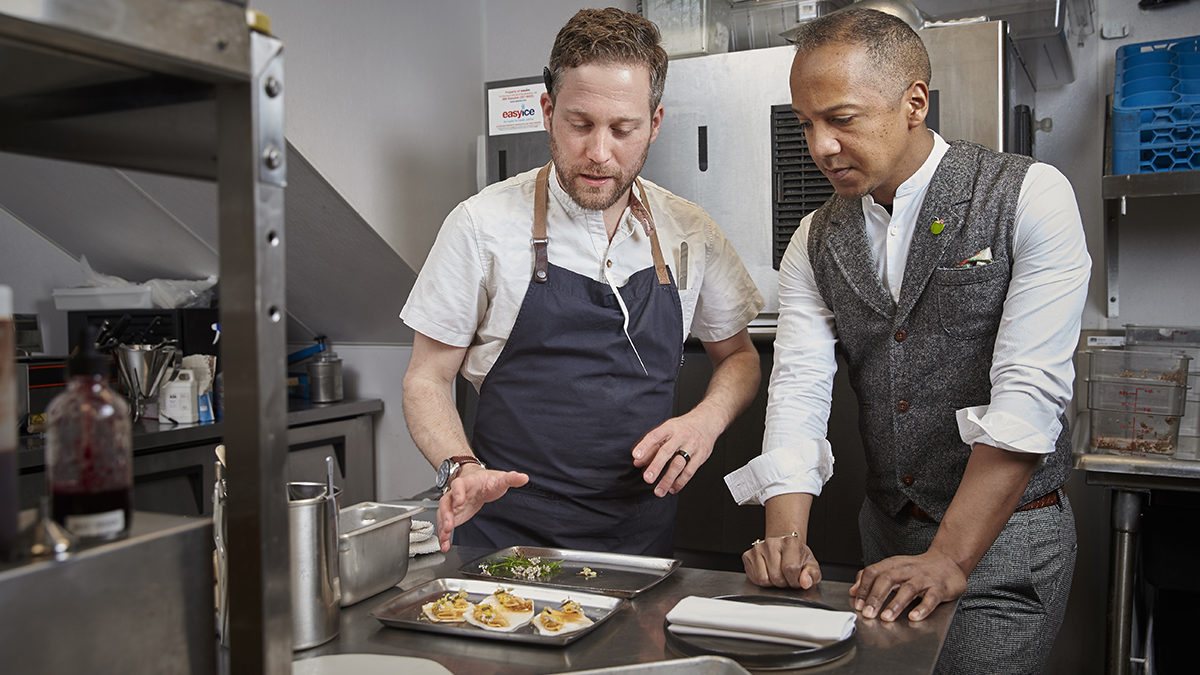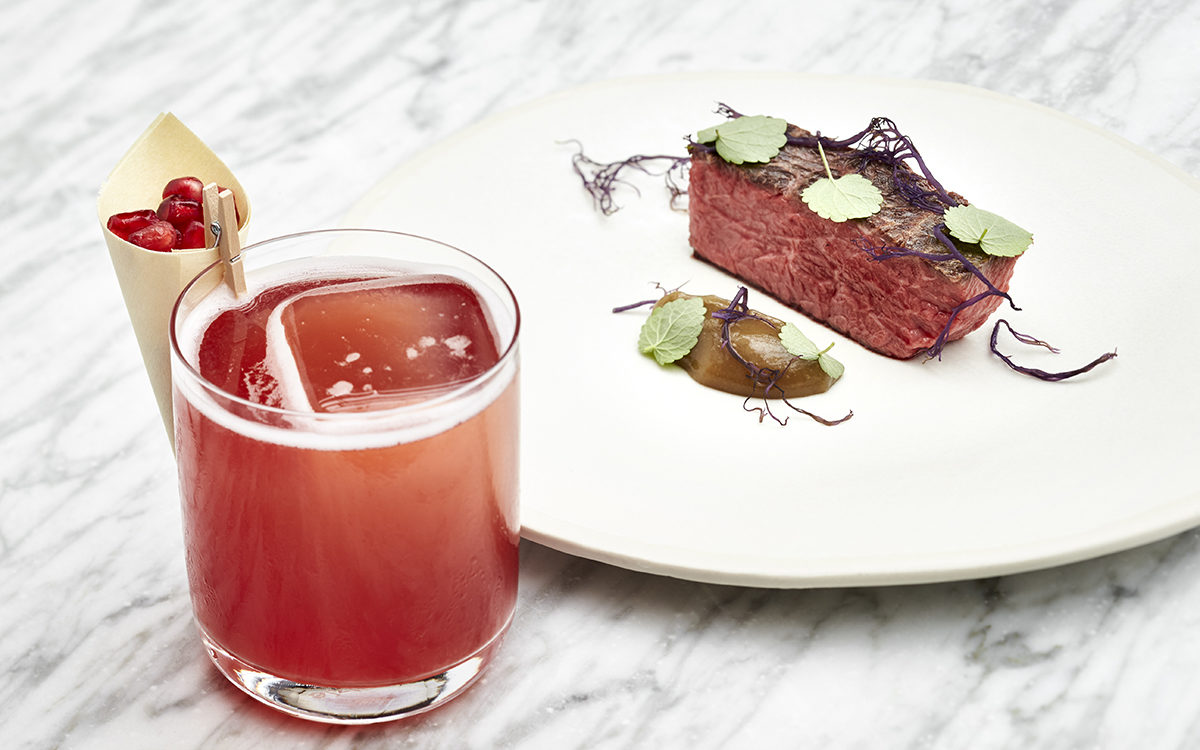From Shaker to Stove
by Kelly Magyarics, DWS | photos by Greg Powers
Johnny Spero and Juan Coronado are like-minded in their belief that the culinary and cocktail worlds are inextricably linked. “If you are a guest and you come into a restaurant for the first time, you need to see the synergy working from the dish to the drink,” Coronado says. He remembers his early days in the restaurant industry, when a French chef declared the kitchen to be his domain and his alone, kicking everyone else out.
Today, that way of thinking is stifling and outdated. So if your concept serves Asian food, he says, skip the Sidecar on the cocktail list and serve drinks influenced by ingredients on the food menu: saké, soju and seaweed, for example. “Bartenders should always leverage from the opportunity and buying power of the kitchen.”
Spero and Coronado met four and a half years ago, when they were both working under José Andrés, a chef known for creative and boundary-pushing food and drinks. The duo quickly discovered that the wall between kitchen and bar was, and should be, invisible, and developed a fast rapport.
Today, Spero flexes that muscle as Executive Chef in one of D.C.’s hottest cocktail dens, and later in 2017, he’ll open a modern-American restaurant in an historic alleyway in Georgetown. There, seats will be set around an open kitchen, giving Spero accountability and transparency, as well as instant gratification and feedback from his guests.
Coronado is partner and creative director a Cuban café, bakery and bar with locations in Dupont Circle and Northern Virginia, and is also a rum category ambassador for Bacardi. We recently caught up with them in the kitchen—and behind the bar—working on a multi-course menu pairing.
 “After tasting a cocktail, the way it makes your mouth feel texturally sometimes makes me think about a dish that would work well with it,” says chef Johnny Spero as he collaborates with Juan Coronado.
“After tasting a cocktail, the way it makes your mouth feel texturally sometimes makes me think about a dish that would work well with it,” says chef Johnny Spero as he collaborates with Juan Coronado.
It turns out that the philosophy of pairing cocktails and food, they say, is very similar to that of fork and cork: either contrasting or complementing flavors work best. Big, bold, grilled bison steak is great next to a smoky, peated Scotch-based cocktail, while a dish with onions, carrots and leeks cozies up nicely to sweet and sour drinks that enhance the journey of the food. On the flip side, earthy, creamy ingredients like mushrooms partner with aperitif-style libations with vermouth or Sherry. “I always try to keep the drinks approachable and under two ounces, but still rich and complex,” Coronado explains. “I can always tweak them to lean more toward vegetal, salty and savory.” That works just fine for Spero, who prefers low-ABV sips as they tend to draw out more subtle notes and light flavors that just can’t push through in boozier beverages.
And what about the role of texture? When Spero was first starting out, he never really gave much thought to the mouthfeel of a glass of wine or a cocktail. “Juan was the first one who got me to think about how a dish tastes or feels in your mouth, and how that affects what you should pair with it,” he recalls. “Those tiny details are what separate the really great chefs and bartenders.”
PARTNERSHIP IN ACTION
Uni is one of Spero’s favorite ingredients, and it usually finds its way onto his menus. He likes to buy it from Samuel’s Seafood in Philadelphia, which has access to rich and creamy varieties coming from Japan as well as versions sourced from the West Coast—which he prefers for their chewier texture. For his uni toast, he steams tiny nubs of uni (generally overlooked by chefs seeking the more perfect- looking larger tongues), and blends them with Vermont cultured butter for creaminess and seaweed stock for texture. The mixture is piped on top of a charred classic cracker made with active dry yeast, garnished with sweet coriander blossoms and peppery arugula flowers and topped with shaved cured egg yolks.
 Spero’s uni toast is creamy and rich, so Coronado matches it with a Bacardi Carta Blanca Rum, tomato water, Martini & Rossi Dry Vermouth and lemon juice quaff designed to “jump start” the palate.
Spero’s uni toast is creamy and rich, so Coronado matches it with a Bacardi Carta Blanca Rum, tomato water, Martini & Rossi Dry Vermouth and lemon juice quaff designed to “jump start” the palate.
For Spero, a dish usually comes before a drink—but Coronado has altered his thought process. “My mentality has definitely changed by working with someone like Juan; alcohol can definitely inspire a food pairing more than I originally thought,” he admits. “After tasting a cocktail, the way it makes your mouth feel tex- turally sometimes makes me think about a dish that would work well with it.” And ingredient- driven drinks like Coronado’s are definitely easy to pair, he says
Another of Spero’s creations starts with dairy cow, admittedly way more popular in Europe than in the United States. He discovered it a few years ago during a stint as an apprentice at renowned restaurant Mugaritz in San Sebastián, Spain. Because this kind of bovine spends its entire life doing nothing but grazing, it picks up overtly grassy notes—and more of the fatty, chewy textural component Spero seeks out. He sources his from a small farm in southern Virginia and cooks it sous vide for several hours before searing it. It’s served over a sauce made with reduced beef stock thickened with seaweed, and with seaweed pickled with rice wine vinegar and sugar.
 Spero serves a unique cut of meat in the dairy cow, known for its chewy, grassy character, and topped here with reduced beef stock and seaweed pickled with rice wine vinegar and sugar. The dish’s sweet and savory profile matches beautifully with the Cazadores Reposado Tequila cocktail, made with beet juice, lime juice and a passion fruit purée.
Spero serves a unique cut of meat in the dairy cow, known for its chewy, grassy character, and topped here with reduced beef stock and seaweed pickled with rice wine vinegar and sugar. The dish’s sweet and savory profile matches beautifully with the Cazadores Reposado Tequila cocktail, made with beet juice, lime juice and a passion fruit purée.
Because the dish is both sweet and savory, it’s an effortless match with a beet-based drink from Coronado. He starts with Cazadores Reposado Tequila®, which is mixed with beet juice (to cut through the meat), lime juice, passion fruit purée (which lends acidity) and a syrup infused with vanilla (when you cook agave for tequila production, he points out, one of the flavors gleaned from caramelizing the sugars is vanilla). The cocktail is topped with Mt. Fuji Bitters and apricot liqueur, and garnished with a paper cone filled with pomegranate arils clipped to the glass with a tiny clothespin. “Beets are underrated—they run the spectrum of earthy to sweet,” Spero says.
Overall, Spero finds creating dishes to go with Coronado’s inventive concoctionns to be in- finitely more interesting than pairing food and wine. “With wine, the bottle is always going to taste like it does,” he muses. “But the range is so great with cocktails; if someone has a really amazing cocktail and wants to showcase it, as chefs we should be versatile enough to taste it and say, ‘Okay, I can work with that.’”


